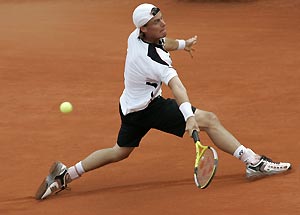Sweet revenge for Rafa as de Minaur downed to keep legend's Madrid fairytale alive
Alex de Minaur has missed out on the chance of a lifetime to beat Rafael Nadal on clay in successive tournaments, blown away by…

The naming of the new tennis stadium in Sydney after the great Ken Rosewall gave sports lovers probably a last chance to watch the disciplined elegance of his stroke play, as he hit some balls on the court for the television cameras, and to listen to his words of wisdom of why Australian tennis is at such a low ebb.
Even in his 70s, Rosewall still strokes the ball beautifully and for a moment or two watching the master took you back to the sepia-tinted days when he was a kid playing those electric matches with the tousled haired Lew Hoad.
The modesty and keen tennis mind that was a mark of the Australian tennis stars in the game’s golden era – Sedgman, Rosewall, Hoad, and Laver (arguably the greatest tennis player of all time) – was clearly obvious when Rosewall discussed the modern game with a television interviewer.
He said that he couldn’t have matched the modern players with their big rackets that enabled them to belt the cover off the ball because he was too small.
Perhaps.
But those of us of a certain age would love to see how Rosewall would confound a modern player by sometimes powering and sometimes finessing that superb backhand down the line or across the court.
Asked about the decline of the Australian game, Rosewall made the point that when tennis came into the Olympic Games, it opened up funding in a host of countries that hadn’t had much to do with the game before.
With the funding came new star players.
He also thought that the Australian youngsters competed very well against each other, but when they came up against overseas players, they just were competitive.
This year, for instance, Lleyton Hewitt was the only Australian representative on the ATP tour.
There was a final Rosewall point: the fact that the overseas players were brought up on clay courts.
I think that this is a key point.
You have to develop a strong all-round game, with very secure ground strokes, to be effective on clay. The overseas players are getting this grounding and the Australian players are not. A few weeks back, though, Tennis Australia announced – at last – that it was developing clay courts in a number of centres to help create a new generation of Australian stars.
In Rosewall’s era, Australia had a comparative advantage in tennis with a particularly strong schools competition (John Newcombe played an exhibition match on the cricket oval at Shore to highlight his prowess); there was an intense club competition; and there were hundreds of grass courts.
This last advantage, the grass courts, is barely acknowledged, but may have been the crucial factor in the golden age of Australian tennis.
For before the big rackets, tennis was a lawn tennis game.
The rackets were made of wood (remember those Dunlop frames?) and had small heads. The game required all-court skills, sound ground strokes, crisp volleying, and variety in tactics and shots.
The move away from grass courts, the high-tech rackets, and the introduction of the faster balls allowed for the rise of the one-trick power players from the back court like Ivan Lendl, and all the top-spin artists, also playing from the back court.
These skills are virtually impossible to learn on grass.
And so a couple of generations of Australian players, with the occasional exceptions like Pat Cash and Lleyton Hewitt, failed to break through to the top echelons of the game.
If this analysis has any merit, it becomes obvious that Australian youngsters, from a very early age, should be exposed for many years to clay courts.
Unfortunately, these courts do not exist here in Australia right now in the numbers required to develop the new Rosewalls of the game.